Ammonia (ammonia) as a fertilizer for plants (tomatoes, cucumbers, onions, garlic): preparation and application of a solution for feeding
Today, you will not surprise anyone with the use of pharmaceutical products in horticulture and horticulture. Indeed, some funds are very, very effective (for example, the same chlorhexidine or diamond green for pre-sowing seed treatment), but by no means all ...
In this article, we will try to figure out whether it is possible and how to use an ammonia solution (ammonia) to feed plants. Does this make sense or is it better to give preference to others nitrogen fertilizers?
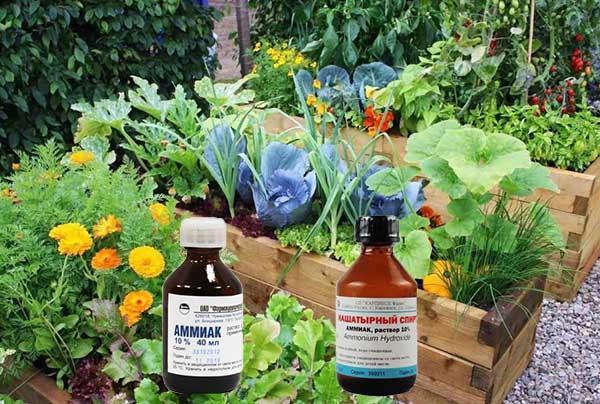
Content
Should I use ammonia for plant nutrition?
On the Internet, you can find a huge amount of advice on the use of ammonia solution (ammonia) for plant nutrition, as well as for the prevention and control of certain pests.
However, despite the assurances and arguments of the adherents of using this drug in the garden and garden, you need to know the following:
- 10% ammonia solution (ammonia) is very unconcentrated nitrogen fertilizersince it contains only 8-9% nitrogen.
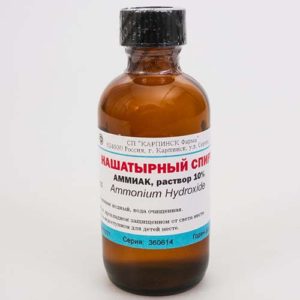
Note! For example, in urea (carbamide) - 46%, in ammonium nitrate - up to 35% (all mineral nitrogen fertilizers). Less only in organic fertilizers .. but ammonia solution is not organic.
- Ammonia instantly evaporates... In other words, while you dilute it with water, water it, very little nitrogen will remain there (2-3 times less than it was originally).
- At the same time, ammonia is sufficient toxic during evaporation (including for plants).
When preparing the working solution, it is necessary observe safety precautions... You must wear glasses and gloves. If the solution gets on your hands, then immediately rinse with water. Work only outdoors (in no case in a closed greenhouse) and do not sniff the concentrate (if it is a 25% solution).
Do you remember why people smell ammonia? That's right, to quickly bring to the senses a person who is in a fainting state.
- Eventually, efficiency this fertilizer not just low, but scanty.. one might even say microscopic (if we consider such important parameters as price-quality).
100 ml of 10% ammonia solution (8-9% nitrogen) in the pharmacy costs about 30-35 rubles, whereas 1 kg urea (46% nitrogen) — 40-45 rubles, ammonium nitrate (35%) - 35-40 rubles.
Now calculate how many times this ammonia fertilization will cost you more? 10 times? No, not at 10, but at least at 40-50.
P.S. Of course there is also technical ammonia (ammonia water), which can theoretically be found in hardware and hardware stores, and it will cost relatively cheap (from 35-40 rubles per 0.5 liter), and nitrogen in it may be more (25%), but…
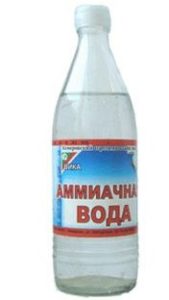
- Ammonia solution (ammonia) is no non organic fertilizer, it has nothing to do with any natural farming.
Why bother so much and use something that is not intended for plants?
Don't like mineral fertilizers? Apply organic.
Need a quick effect? Apply mineral water (urea or ammonium nitrate).
However, use it to feed plants you can still. But you need to do it rightso that there is at least some efficiency.
How to properly prepare a solution of ammonia (ammonia) for plant nutrition
First, let's immediately figure out how do not use ammonia to fertilize plants.
Most "advanced" gardeners are advised to prepare top dressing as follows: 1-3 st. spoons dissolve ammonia solution in 10 liters of water and pour over the root (root feeding) or carry out spraying over the leaves (foliar feeding).
However, this method is extremely ineffective and even dangeroussince in a greenhouse (greenhouse), ammonia poisoning of plants can occur.
To reduce evaporation loss of ammoniaand also to exclude ammonia poisoning of plants (so as not to emit toxic fumes), you need to extinguish the ammonia solution (neutralize its alkaline reaction). To do this, you can use the following acidic remedies:
- 9% table vinegar (for 1 tablespoon of 10% ammonia solution - 5-6 tablespoons of 9% vinegar).
Also suitable Apple vinegar.
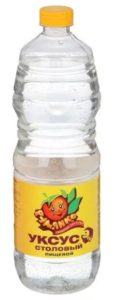
- dry citric acid (1 to 1, for 1 tbsp. L 10% ammonia - 1 tsp citric acid);
In the end, you will succeed ammonium citrate.
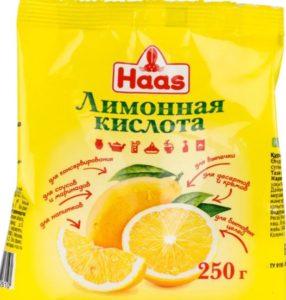
- milk whey (for 1 tbsp. l of 10% ammonia - 350 ml of serum).
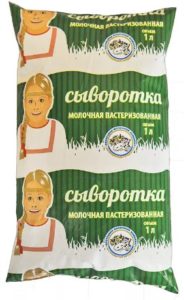
Similarly to the action of the above means (neutralizers), you can prepare a complex nitrogen-phosphorus-potassium supplement. To do this, you need to add 10 liters of water 3 tbsp. tablespoons of ammonia and 1 tbsp. spoon of potassium monophosphate (mineral phosphorus-potassium fertilizer).
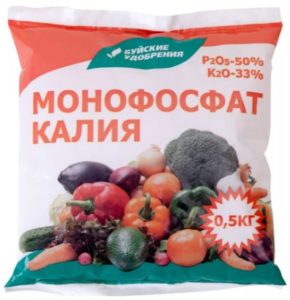
By the way! The use of neutralizers (various acids: vinegar, citric acid) also positively affects the absorption of phosphates by plants (the same superphosphate). In addition, phosphorus fertilizers can be dissolved in an ammonia solution in order to immediately carry out complex nitrogen-phosphorus fertilizing.
What plants can be fed with ammonia solution: when and how to use, what else is ammonia good for in the garden
This solution can be fed absolutely any plants... In other words, a solution of ammonia (ammonia) is suitable for feeding tomatoes, cucumbers, peppers, eggplants, cabbage, onions, garlic and other vegetables, as well berry bushes - strawberries, raspberries, currants, gooseberries and colors.
- When to feed plants with ammonia solution?
In the initial phase of growth, when plants need a lot of nitrogen (i.e. in spring and early summer, before flowering).
- How to prepare the solution?
For 10 liters of water, take from 1 to 3 tbsp. tablespoons of ammonia solution (if 10%, then 3 tablespoons, if 25%, then 1), add a neutralizer (vinegar, citric acid, milk whey). See paragraph above.
- How much ammonia solution is needed for 1 plant?
About 0.5-1 liters of working solution per bush, depending on the phase of plant development (more in the initial period of growth, then less).
- What is the best way to feed plants with ammonia solution?
You can either water at the root (make root feeding), or spray on the leaves (foliar feeding).
- Is Ammonia Suitable for Pest Control?
Indeed, ammonia is quite can scare off most pests with its smelly and suffocating odor: the same carrot and onion flour and even aphids and weevil, but the effect will not be long lasting (to repeat will have enough often). But to somehow act on earth pests - on bear, wireworm the ammonia solution can hardly ... just not get there.
In general, use products that are more suitable for pest control (insecticides).
What else can ammonia be used in the garden and vegetable garden?
An aqueous solution of ammonia (ammonia) is very alkaline. Accordingly, it can be used as a quencher (neutralizer) of acidity, so to speak, a deoxidizer, for example, for succinic acid, boric acid, acetic acid, whey (for all types of acids), but in very small quantities (1-2 tablespoons). Why is this needed? The fact is that most plants prefer to grow in soils with neutral acidity, which means that neutral solutions (not acidic and not alkaline) should be used to feed and process them.
Well, now you know how to properly use an ammonia solution (ammonia) to feed plants (tomatoes, cucumbers). Whether it is worth using this very ineffective pharmaceutical agent as a nitrogen fertilizer is up to you.
The author is convinced that there is no point in using ammonia as an alternative to conventional = normal nitrogen fertilization.

